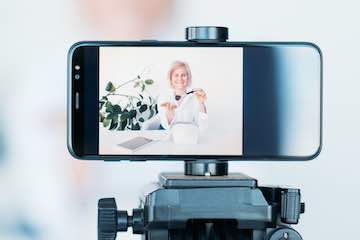
Let’s face it. Manufacturer-supplied photos are not the greatest. They often lack context and don’t provide a personalized experience. Most aren’t ideal for landing pages.
Professional photographers can help tell a product’s story. However, photo sessions are cumbersome and pricey, especially for multiple set changes and entire product portfolios.
Need an alternative? Consider a modern smartphone. The cameras on today’s phones have more features and better resolution than expensive options of just a few years ago. The latest iPhone or Android device, paired with a few essentials, is all it takes to create compelling images that trigger emotion.
The first step is getting to know your smartphone’s camera. Take a course or two to practice with all the settings and learn about standard composition — where to place things and what to focus on.
Raw photos without filters are best so designers and photo editors can work their magic. Still, add four tools to the mix.
Smartphone Photography Tools
Green screen. If you don’t have the perfect set, you can take pictures of large objects and people against a green backdrop. A solid color background is easy to remove in post-production editing. It could be any color, but green is most common as it’s different from human skin colors. Thus, the “green screen.”
A 10-foot by 12-foot screen works for most setups that include a few people. Use a sturdy, adjustable frame to prevent shadows. A steam iron can remove wrinkles. If you have space, paint a wall and part of the floor with “Chroma Key Green,” which runs about $85 per gallon. (“Chroma” refers to a color’s intensity.)
Lighting kit. A standard lighting kit can remove shadows and provide consistency.
Umbrella lights are portable, easy to use, and emulate the outdoors. Most kits include umbrellas to diffuse white (intense) light and bounce hard (direct) light. Practice placement to get an even glow on the subject.
Lightbox. Also called a shooting tent, a lightbox is essential for small objects, such as toys, footwear, and food. The best lightboxes include a lighting strip across the top that provides even light throughout, as well as door panels to shoot or shine light from multiple angles.
Lightboxes come in various sizes. Go with the largest you may need. For example, a 32-inch lightbox will accommodate a carry-on suitcase.
Tripod. A quality, adjustable tripod is essential for clear pictures. A tabletop version may be sufficient. However, a scalable tripod with a 360-degree tilting head is suitable for any angle, distance, or height.
For action shots and scenery, consider a monopod, a single-legged tripod. It’s much easier to reposition, which comes in handy when taking panoramic photos.
Simple Is Better
Avoid using image filters. Many restrict the editing process. Also avoid maximum zoom. Digital zooming can reduce clarity. Crop photos to create an up-close effect.
Photos that are well lit, focused, and unfiltered provide designers and editors with latitude. Take several shots of each subject at different angles for multiple uses, such as email newsletters and social media posts.
A smartphone is no replacement for a talented photographer. But it can help fill the gaps, especially with a few affordable tools.
"Smartphone" - Google News
April 25, 2021 at 07:36PM
https://ift.tt/3dR3SQU
Using a Smartphone for Stellar Product Photos - Practical Ecommerce
"Smartphone" - Google News
https://ift.tt/2QXWyGT
https://ift.tt/2KSW0PQ
Bagikan Berita Ini














0 Response to "Using a Smartphone for Stellar Product Photos - Practical Ecommerce"
Post a Comment